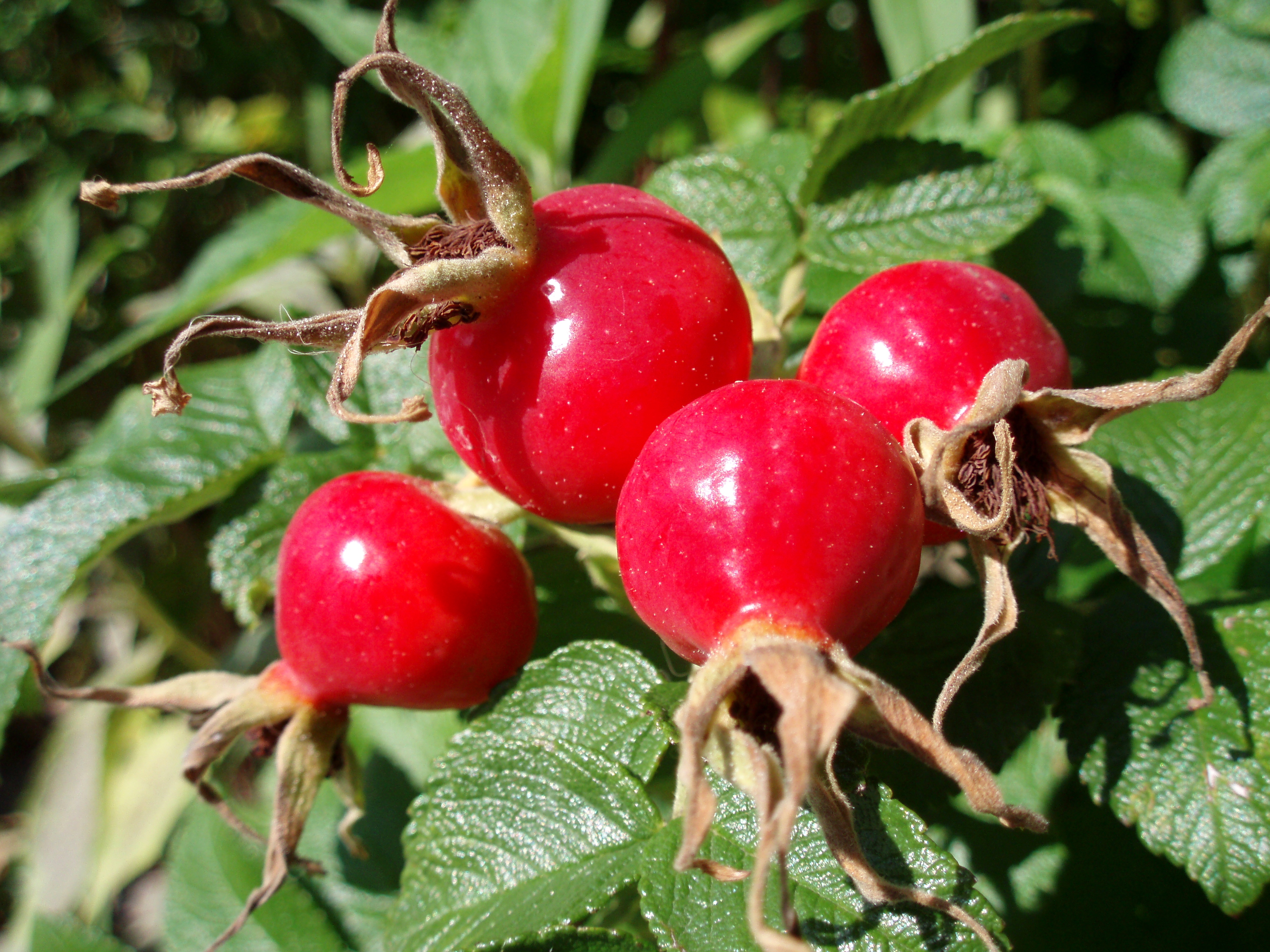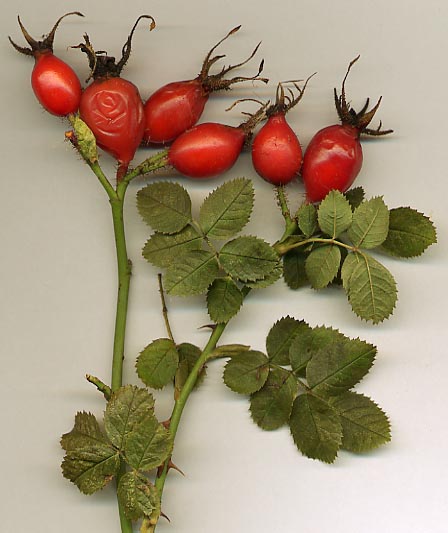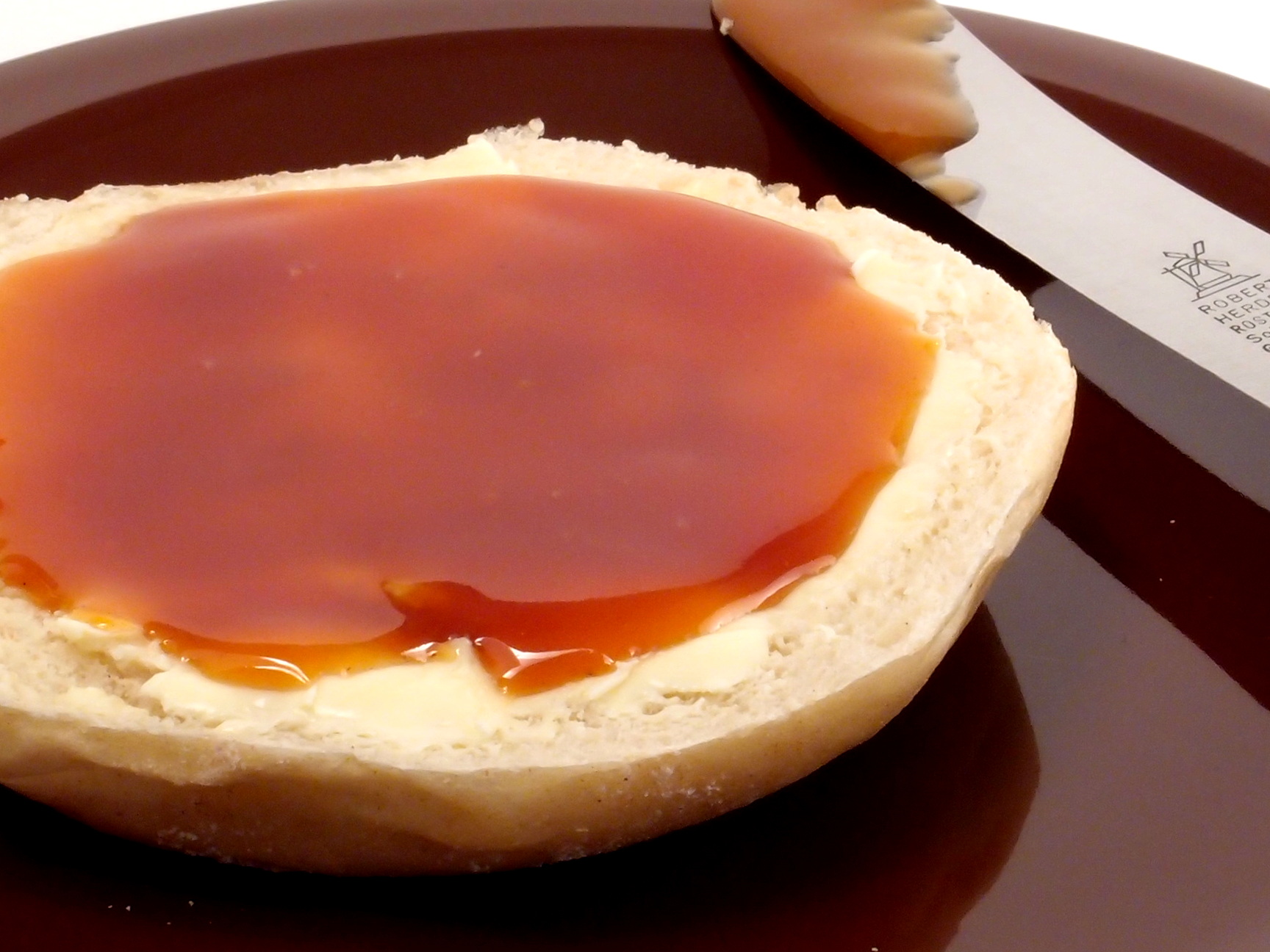rosehip on:
[Wikipedia]
[Google]
[Amazon]

 The rose hip or rosehip, also called rose haw and rose hep, is the
The rose hip or rosehip, also called rose haw and rose hep, is the
 Rose hips are used in
Rose hips are used in

 The rose hip or rosehip, also called rose haw and rose hep, is the
The rose hip or rosehip, also called rose haw and rose hep, is the accessory fruit
An accessory fruit is a fruit in which some of the flesh is derived not from the floral ovary but from some adjacent tissue exterior to the carpel.Esau, K. 1977. ''Anatomy of seed plants''. John Wiley and Sons, New York. Accessory fruits are u ...
of the various species of rose plant. It is typically red to orange, but ranges from dark purple to black in some species. Rose hips begin to form after pollination of flowers in spring or early summer, and ripen in late summer through autumn.
Propagation
Roses are propagated from rose hips by removing theachene
An achene (; ), also sometimes called akene and occasionally achenium or achenocarp, is a type of simple dry fruit produced by many species of flowering plants. Achenes are monocarpellate (formed from one carpel) and indehiscent (they do not ope ...
s that contain the seeds from the hypanthium
In angiosperms, a hypanthium or floral cup is a structure where basal portions of the calyx, the corolla, and the stamens form a cup-shaped tube. It is sometimes called a floral tube, a term that is also used for corolla tube and calyx tube. It ...
(the outer coating) and sowing just beneath the surface of the soil. The seeds can take many months to germinate. Most species require chilling ( stratification), with some such as ''Rosa canina
''Rosa canina'', commonly known as the dog rose, is a variable climbing, wild rose species native to Europe, northwest Africa, and western Asia.
Description
The dog rose is a deciduous shrub normally ranging in height from , though sometimes it ...
'' only germinating after two winter chill periods.
Use
 Rose hips are used in
Rose hips are used in bread
Bread is a staple food prepared from a dough of flour (usually wheat) and water, usually by baking. Throughout recorded history and around the world, it has been an important part of many cultures' diet. It is one of the oldest human-made food ...
and pies, jam,
jelly, marmalade, syrup, soup, tea
Tea is an aromatic beverage prepared by pouring hot or boiling water over cured or fresh leaves of ''Camellia sinensis'', an evergreen shrub native to East Asia which probably originated in the borderlands of southwestern China and norther ...
, wine, and other beverage
A drink or beverage is a liquid intended for human consumption. In addition to their basic function of satisfying thirst, drinks play important roles in human culture. Common types of drinks include plain drinking water, milk, juice, smoothies ...
s.
Rose hips can be eaten raw, like berries, if care is taken to avoid the hairs inside the fruit. The hairs are used as itching powder.
A few rose species are sometimes grown for the ornamental value of their hips, such as ''Rosa moyesii
''Rosa moyesii'' is a species of flowering plant in the rose family Rosaceae, native to western China . Growing to tall by wide, it is a vigorous deciduous shrub, with plentiful matte green leaves and flat red or pink flowers, with yellow centr ...
'', which has prominent, large, red bottle-shaped fruits. ''Rosa macrophylla
''Rosa macrophylla'', the big-hip rose, is a species of flowering plant in the family Rosaceae, native to the Himalayan region. There are a number of cultivars, including 'Doncasteri', 'Glaucescens', 'Master Hugh', and 'Rubricaulis'. 'Master Hugh ...
'' 'Master Hugh' has the largest hips of any readily available rose.
Rose hips are commonly used in herbal tea, often blended with hibiscus. An oil is also extracted from the seeds. Rose hip soup
Rose hip soup ( sv, Nyponsoppa) is a Swedish soup made from rose hips. It is served as a beverage or as a dessert with milk, cream or vanilla ice cream along with small almond biscuits.
Rose hip soup may be eaten for breakfast. The types of sou ...
, known as in Swedish, is especially popular in Sweden. Rhodomel
Mead () is an alcoholic beverage made by fermenting honey mixed with water, and sometimes with added ingredients such as fruits, spices, grains, or hops. The alcoholic content ranges from about 3.5% ABV to more than 20%. The defining characte ...
, a type of mead, is made with rose hips.
Rose hips can be used to make , the traditional Hungarian fruit brandy popular in Hungary, Romania, and other countries sharing Austro-Hungarian history. Rose hips are also the central ingredient of cockta
Cockta () is a soft drink from Croatia. Its main ingredient comes from dog rose hip; the other ingredients come from 11 different herbs, lemon and orange. Its original variant contains neither caffeine nor orthophosphoric acid.
Origins
The orig ...
, the fruity-tasting national soft drink of Slovenia.
Dried rose hips are also sold for crafts and home fragrance purposes. The Inupiat mix rose hips with wild redcurrant and highbush cranberries and boil them into a syrup.
Nutrients and phytochemicals
Wild rose hip fruits are particularly rich in vitamin C, containing 426 mg per 100 g or 0.4% by weight (w/w). However,RP-HPLC
High-performance liquid chromatography (HPLC), formerly referred to as high-pressure liquid chromatography, is a technique in analytical chemistry used to separate, identify, and quantify each component in a mixture. It relies on pumps to p ...
assays of fresh rose hips and several commercially available products revealed a wide range of L-ascorbic acid (vitamin C) content, ranging from 0.03 to 1.3%.
Rose hips contain the carotenoid
Carotenoids (), also called tetraterpenoids, are yellow, orange, and red organic pigments that are produced by plants and algae, as well as several bacteria, and fungi. Carotenoids give the characteristic color to pumpkins, carrots, parsnips, ...
s beta-carotene, lutein
Lutein (;"Lutein"
zeaxanthin
Zeaxanthin is one of the most common carotenoids in nature, and is used in the xanthophyll cycle. Synthesized in plants and some micro-organisms, it is the pigment that gives paprika (made from bell peppers), corn, saffron, goji ( wolfberries), ...
and lycopene, which are under basic research
Basic research, also called pure research or fundamental research, is a type of scientific research with the aim of improving scientific theories for better understanding and prediction of natural or other phenomena. In contrast, applied researc ...
for a variety of potential biological roles. A meta-analysis of human studies examining the potential for rose hip extracts to reduce arthritis
Arthritis is a term often used to mean any disorder that affects joints. Symptoms generally include joint pain and stiffness. Other symptoms may include redness, warmth, swelling, and decreased range of motion of the affected joints. In some ...
pain concluded there was a small effect requiring further analysis of safety and efficacy in clinical trials
Clinical trials are prospective biomedical or behavioral research studies on human participants designed to answer specific questions about biomedical or behavioral interventions, including new treatments (such as novel vaccines, drugs, dietar ...
. Use of rose hips is not considered an effective treatment for knee osteoarthritis.
See also
*Rose hip seed oil
Rose hip seed oil is a pressed seed oil, extracted from the seeds of the wild rose bush ''Rosa rubiginosa'' ( es, rosa mosqueta) in the southern Andes. Rosehip seed oil can also be extracted from ''Rosa canina'', a wild rose species native to Eu ...
*Rose hip soup
Rose hip soup ( sv, Nyponsoppa) is a Swedish soup made from rose hips. It is served as a beverage or as a dessert with milk, cream or vanilla ice cream along with small almond biscuits.
Rose hip soup may be eaten for breakfast. The types of sou ...
* Rose hip wine
*''Rosa moschata
''Rosa moschata'', the musk rose, is a species of rose which has been long in cultivation. Its wild origins are uncertain but are suspected to lie in the western Himalayas.
Description
''Rosa moschata'' is a shrub (to 3m) with single white 5&nb ...
''
*''Rosa rubiginosa
''Rosa rubiginosa'' (sweet briar, sweetbriar rose, sweet brier or eglantine; syn. ''R. eglanteria'') is a species of rose native to Europe and western Asia.
Description
It is a dense deciduous shrub 2–3 meters high and across, with the stem ...
''
*''Rosa gymnocarpa
''Rosa gymnocarpa'' is a species of rose native to western North America. It is known by the common names dwarf rose, baldhip rose, and wood rose. It grows in shady, damp, and rich forests.
Description
''Rosa gymnocarpa'' is a perennial shrub gr ...
'', the bald-hip rose
References
External links
* {{Authority control Fruit morphology Herbal tea Roses Food ingredients